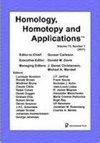Structure of semi-continuous $q$-tame persistence modules
IF 0.5
4区 数学
Q2 MATHEMATICS
引用次数: 4
Abstract
Using a result by Chazal, Crawley-Boevey and de Silva concerning radicals of persistence modules, we show that every lower semi-continuous q-tame persistence module can be decomposed as a direct sum of interval modules and that every upper semi-continuous q-tame persistence module can be decomposed as a product of interval modules.半连续$q$-tame持久化模块的结构
利用Chazal、Crawley-Boevey和de Silva关于持久模根的结果,证明了每一个下半连续q-tame持久性模都可以分解为区间模的直接和,每一个上半连续q-tame持久性模都可以分解为区间模的乘积。
本文章由计算机程序翻译,如有差异,请以英文原文为准。
求助全文
约1分钟内获得全文
求助全文
来源期刊
CiteScore
1.10
自引率
0.00%
发文量
37
审稿时长
>12 weeks
期刊介绍:
Homology, Homotopy and Applications is a refereed journal which publishes high-quality papers in the general area of homotopy theory and algebraic topology, as well as applications of the ideas and results in this area. This means applications in the broadest possible sense, i.e. applications to other parts of mathematics such as number theory and algebraic geometry, as well as to areas outside of mathematics, such as computer science, physics, and statistics. Homotopy theory is also intended to be interpreted broadly, including algebraic K-theory, model categories, homotopy theory of varieties, etc. We particularly encourage innovative papers which point the way toward new applications of the subject.

 求助内容:
求助内容: 应助结果提醒方式:
应助结果提醒方式:


